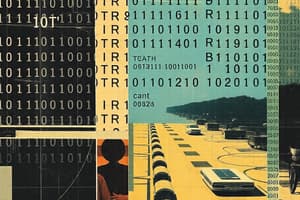Podcast
Questions and Answers
What is the main function of the central processing unit (CPU) in a computer?
What is the main function of the central processing unit (CPU) in a computer?
- To perform calculations and manipulations on data (correct)
- To input data from external devices
- To store data permanently
- To display results to the user
Which of the following types of computers is specifically designed for individual use?
Which of the following types of computers is specifically designed for individual use?
- Supercomputers
- Personal Computers (PCs) (correct)
- Mainframes
- Workstations
In the Von Neumann architecture, how are data and instructions stored?
In the Von Neumann architecture, how are data and instructions stored?
- In separate memory locations accessed simultaneously
- In a single memory location accessed sequentially (correct)
- Only in RAM without permanent storage
- In a distributed system across multiple machines
Which of the following is NOT considered an input device?
Which of the following is NOT considered an input device?
What does application software primarily do?
What does application software primarily do?
Which storage option provides temporary data storage for active tasks?
Which storage option provides temporary data storage for active tasks?
What type of computer is typically used by large organizations to manage vast amounts of data?
What type of computer is typically used by large organizations to manage vast amounts of data?
Which of the following operating systems is an example of software that manages computer hardware?
Which of the following operating systems is an example of software that manages computer hardware?
Flashcards
What is a computer?
What is a computer?
A programmable electronic device that processes data based on instructions.
What is input?
What is input?
The process of accepting data from the outside world, like typing on a keyboard or taking a picture with a camera.
What does it mean to process data?
What does it mean to process data?
The process of performing calculations and manipulations on the input data. This is where the computer actually does the work.
What is storage in a computer?
What is storage in a computer?
Signup and view all the flashcards
What is output?
What is output?
Signup and view all the flashcards
What is the CPU's role?
What is the CPU's role?
Signup and view all the flashcards
What is RAM?
What is RAM?
Signup and view all the flashcards
What is the purpose of a HDD or SSD?
What is the purpose of a HDD or SSD?
Signup and view all the flashcards
Study Notes
Defining Computer
- A computer is a programmable electronic device that manipulates data according to a set of instructions.
Key Functions of a Computer
- Input: Accepts data from the outside world. Examples include keyboards, mice, touchscreens, scanners, and microphones.
- Processing: Performs calculations and manipulations on the input data. The central processing unit (CPU) is the primary component for this.
- Storage: Holds input data, processed results, and instructions for future use. This can include RAM, hard drives, and cloud storage.
- Output: Presents the processed data to the user. Examples include monitors, printers, speakers, and projectors.
Types of Computers
- Personal Computers (PCs): General-purpose devices designed for individual use, ranging from desktops to laptops.
- Workstations: Powerful computers typically used for specialized tasks, such as graphic design or scientific computing.
- Servers: Computers dedicated to providing services to other computers or devices on a network.
- Mainframes: Large, powerful computers used by large organizations for managing vast amounts of data.
- Supercomputers: The most powerful computers used for complex scientific simulations and calculations.
Computer Components
- Central Processing Unit (CPU): The "brain" of the computer, responsible for executing instructions.
- Memory (RAM): Short-term storage for data and instructions currently being used by the CPU.
- Hard Disk Drive (HDD) or Solid State Drive (SSD): Permanent storage for data and programs.
- Input Devices: Devices used to enter data into the computer.
- Output Devices: Devices used to display the results of processing.
- Motherboard: Connects all components of the computer.
Computer Architecture
- Von Neumann Architecture: A common computer architecture where data and instructions are stored in the same memory and accessed sequentially.
- Harvard Architecture: A type of computer architecture where instructions and data are stored in separate memory locations, allowing for simultaneous fetching, improving execution speeds.
Computer Software
- Operating Systems: Software that manages computer hardware and software resources. Examples include Windows, macOS, and Linux.
- Application Software: Software programs designed for specific tasks, such as word processing, web browsing, or video editing.
Data Representation
- Binary System: The fundamental way computers represent information using 0s and 1s (bits), the language of electronics.
- Data Types: Computers represent different kinds of data, including numbers, text, images, and audio.
Computer Networks
- Networks connect computers enabling communication and resource sharing.
- Internet: The global network connecting billions of devices worldwide.
Computer History
- Early computers were enormous and slow.
- Over time, computers have become smaller, faster, and more powerful.
- Moore's Law and advancements in semiconductor technology explain much of the progression.
Studying That Suits You
Use AI to generate personalized quizzes and flashcards to suit your learning preferences.



